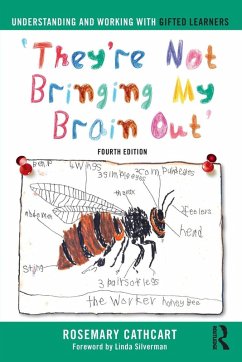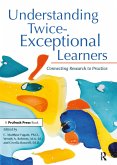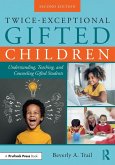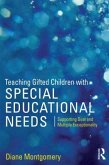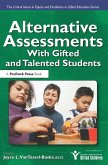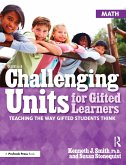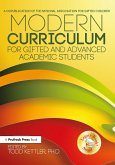- Broschiertes Buch
- Merkliste
- Auf die Merkliste
- Bewerten Bewerten
- Teilen
- Produkt teilen
- Produkterinnerung
- Produkterinnerung
This book provides teachers with effective strategies for understanding and teaching gifted learners. It answers the questions teachers most commonly ask about who gifted learners are, why they need support and where parents fit into the picture.
Andere Kunden interessierten sich auch für
![Understanding Twice-Exceptional Learners Understanding Twice-Exceptional Learners]() C. Matthew FugateUnderstanding Twice-Exceptional Learners49,99 €
C. Matthew FugateUnderstanding Twice-Exceptional Learners49,99 €![Twice-Exceptional Gifted Children Twice-Exceptional Gifted Children]() Beverly A. TrailTwice-Exceptional Gifted Children25,99 €
Beverly A. TrailTwice-Exceptional Gifted Children25,99 €![Teaching Gifted Children with Special Educational Needs Teaching Gifted Children with Special Educational Needs]() Diane Montgomery (Middlesex University, London, UK)Teaching Gifted Children with Special Educational Needs53,99 €
Diane Montgomery (Middlesex University, London, UK)Teaching Gifted Children with Special Educational Needs53,99 €![Challenging Units for Gifted Learners Challenging Units for Gifted Learners]() Kenneth J. SmithChallenging Units for Gifted Learners38,99 €
Kenneth J. SmithChallenging Units for Gifted Learners38,99 €![Alternative Assessments With Gifted and Talented Students Alternative Assessments With Gifted and Talented Students]() Joyce VanTassel-BaskaAlternative Assessments With Gifted and Talented Students48,99 €
Joyce VanTassel-BaskaAlternative Assessments With Gifted and Talented Students48,99 €![Challenging Units for Gifted Learners Challenging Units for Gifted Learners]() Kenneth J. SmithChallenging Units for Gifted Learners38,99 €
Kenneth J. SmithChallenging Units for Gifted Learners38,99 €![Modern Curriculum for Gifted and Advanced Academic Students Modern Curriculum for Gifted and Advanced Academic Students]() Todd A. KettlerModern Curriculum for Gifted and Advanced Academic Students68,99 €
Todd A. KettlerModern Curriculum for Gifted and Advanced Academic Students68,99 €-
-
-
This book provides teachers with effective strategies for understanding and teaching gifted learners. It answers the questions teachers most commonly ask about who gifted learners are, why they need support and where parents fit into the picture.
Produktdetails
- Produktdetails
- Verlag: Taylor & Francis Ltd
- Seitenzahl: 288
- Erscheinungstermin: 19. März 2020
- Englisch
- Abmessung: 234mm x 156mm x 16mm
- Gewicht: 448g
- ISBN-13: 9780367443658
- ISBN-10: 0367443651
- Artikelnr.: 58950423
- Herstellerkennzeichnung
- Libri GmbH
- Europaallee 1
- 36244 Bad Hersfeld
- gpsr@libri.de
- Verlag: Taylor & Francis Ltd
- Seitenzahl: 288
- Erscheinungstermin: 19. März 2020
- Englisch
- Abmessung: 234mm x 156mm x 16mm
- Gewicht: 448g
- ISBN-13: 9780367443658
- ISBN-10: 0367443651
- Artikelnr.: 58950423
- Herstellerkennzeichnung
- Libri GmbH
- Europaallee 1
- 36244 Bad Hersfeld
- gpsr@libri.de
Rosemary Cathcart has been involved in almost every role within gifted education from parent to college of education tutor since the mid-1980s. Founder of New Zealand's first national gifted education centre and One Day School, she now heads an international award-winning consultancy specialising in professional development in this field.
Dedication - in gratitude
Acknowledgements
Foreword by Dr Linda Silverman
Preface: Why are we here?
SECTION I: THE ISSUES
Chapter 1. Why bother? They'll succeed anyway, won't they? A reality check!
Chapter 2. So who are they?
Chapter 3. What makes them tick? What makes the gifted gifted?
Chapter 4. Introducing the Holistic Descriptor
Chapter 5. How will I know one when I meet one?
Chapter 6. How do I teach them when I find them? Setting the scene...
SECTION II: RESOLVING THE ISSUES: TEACHING STRATEGIES
Chapter 7. Thinking about attitudes
Chapter 8. Thinking about skills
Chapter 9. Thinking about extension
Chapter 10. Thinking about balance
Chapter 11. Thinking about evaluating one's own work
SECTION III: RESOLVING THE ISSUES: TEACHING STRATEGIES
Chapter 12. Generating a high level of interest in learning
Chapter 13. Developing the tools of thought: observation skills
Chapter 14. Developing the tools of thought: study and research skills
Chapter 15. Developing the tools of thought: communication skills
Chapter 16. Developing the tools of thought: thinking skills
Chapter 17. Developing the tools of thought: organisational skills
Chapter 18. Developing the child's intellectual and creative potential as
far as possible
Chapter 19. Using concepts which challenge the child's current knowledge
and level of thinking
Chapter 20. Drawing on the arts: for those who are not interested as well
as those who are!
Chapter 21. Drawing on the arts: the language of painting
Chapter 22. Drawing on the arts: the language of poetry
Chapter 23. Encouraging original work
Chapter 24. Guiding the gifted reader
Chapter 25. Fostering emotional, social and ethical growth - beginning with
the self
Chapter 26. Fostering growth towards emotional and social maturity
Chapter 27. Fostering ethical growth
Chapter 28. Evaluating our own learning, thinking and creating
SECTION IV: RESOLVING THE ISSUES: LESSON PLANNING
Chapter 29. Conceptual planning: a tool for the teacher
Chapter 30. Conceptual planning: a structure for lessons
Chapter 31. Bringing it all together
SECTION V: GIFTEDNESS AND RELATED DIFFERENT NEEDS
Chapter 32. Gifted children from minority cultures
Chapter 33. The Twice-exceptional child
Chapter 34. The needs of parents with gifted children
SECTION VI: NUTS AND BOLTS
Chapter 35. Nuts and bolts: some basics
Chapter 36. On being A REACH teacher
Endpiece
Appendices
1. Screening checklist for teacher use
2. How do I know if my child/my student is gifted?
3. Student survey - How could I get more out of school?
4. Interest inventory - The Famous YOU!
5. Visual-Spatial Learners: Characteristics comparison - Dr Linda Silverman
Acknowledgements
Foreword by Dr Linda Silverman
Preface: Why are we here?
SECTION I: THE ISSUES
Chapter 1. Why bother? They'll succeed anyway, won't they? A reality check!
Chapter 2. So who are they?
Chapter 3. What makes them tick? What makes the gifted gifted?
Chapter 4. Introducing the Holistic Descriptor
Chapter 5. How will I know one when I meet one?
Chapter 6. How do I teach them when I find them? Setting the scene...
SECTION II: RESOLVING THE ISSUES: TEACHING STRATEGIES
Chapter 7. Thinking about attitudes
Chapter 8. Thinking about skills
Chapter 9. Thinking about extension
Chapter 10. Thinking about balance
Chapter 11. Thinking about evaluating one's own work
SECTION III: RESOLVING THE ISSUES: TEACHING STRATEGIES
Chapter 12. Generating a high level of interest in learning
Chapter 13. Developing the tools of thought: observation skills
Chapter 14. Developing the tools of thought: study and research skills
Chapter 15. Developing the tools of thought: communication skills
Chapter 16. Developing the tools of thought: thinking skills
Chapter 17. Developing the tools of thought: organisational skills
Chapter 18. Developing the child's intellectual and creative potential as
far as possible
Chapter 19. Using concepts which challenge the child's current knowledge
and level of thinking
Chapter 20. Drawing on the arts: for those who are not interested as well
as those who are!
Chapter 21. Drawing on the arts: the language of painting
Chapter 22. Drawing on the arts: the language of poetry
Chapter 23. Encouraging original work
Chapter 24. Guiding the gifted reader
Chapter 25. Fostering emotional, social and ethical growth - beginning with
the self
Chapter 26. Fostering growth towards emotional and social maturity
Chapter 27. Fostering ethical growth
Chapter 28. Evaluating our own learning, thinking and creating
SECTION IV: RESOLVING THE ISSUES: LESSON PLANNING
Chapter 29. Conceptual planning: a tool for the teacher
Chapter 30. Conceptual planning: a structure for lessons
Chapter 31. Bringing it all together
SECTION V: GIFTEDNESS AND RELATED DIFFERENT NEEDS
Chapter 32. Gifted children from minority cultures
Chapter 33. The Twice-exceptional child
Chapter 34. The needs of parents with gifted children
SECTION VI: NUTS AND BOLTS
Chapter 35. Nuts and bolts: some basics
Chapter 36. On being A REACH teacher
Endpiece
Appendices
1. Screening checklist for teacher use
2. How do I know if my child/my student is gifted?
3. Student survey - How could I get more out of school?
4. Interest inventory - The Famous YOU!
5. Visual-Spatial Learners: Characteristics comparison - Dr Linda Silverman
Dedication - in gratitude
Acknowledgements
Foreword by Dr Linda Silverman
Preface: Why are we here?
SECTION I: THE ISSUES
Chapter 1. Why bother? They'll succeed anyway, won't they? A reality check!
Chapter 2. So who are they?
Chapter 3. What makes them tick? What makes the gifted gifted?
Chapter 4. Introducing the Holistic Descriptor
Chapter 5. How will I know one when I meet one?
Chapter 6. How do I teach them when I find them? Setting the scene...
SECTION II: RESOLVING THE ISSUES: TEACHING STRATEGIES
Chapter 7. Thinking about attitudes
Chapter 8. Thinking about skills
Chapter 9. Thinking about extension
Chapter 10. Thinking about balance
Chapter 11. Thinking about evaluating one's own work
SECTION III: RESOLVING THE ISSUES: TEACHING STRATEGIES
Chapter 12. Generating a high level of interest in learning
Chapter 13. Developing the tools of thought: observation skills
Chapter 14. Developing the tools of thought: study and research skills
Chapter 15. Developing the tools of thought: communication skills
Chapter 16. Developing the tools of thought: thinking skills
Chapter 17. Developing the tools of thought: organisational skills
Chapter 18. Developing the child's intellectual and creative potential as
far as possible
Chapter 19. Using concepts which challenge the child's current knowledge
and level of thinking
Chapter 20. Drawing on the arts: for those who are not interested as well
as those who are!
Chapter 21. Drawing on the arts: the language of painting
Chapter 22. Drawing on the arts: the language of poetry
Chapter 23. Encouraging original work
Chapter 24. Guiding the gifted reader
Chapter 25. Fostering emotional, social and ethical growth - beginning with
the self
Chapter 26. Fostering growth towards emotional and social maturity
Chapter 27. Fostering ethical growth
Chapter 28. Evaluating our own learning, thinking and creating
SECTION IV: RESOLVING THE ISSUES: LESSON PLANNING
Chapter 29. Conceptual planning: a tool for the teacher
Chapter 30. Conceptual planning: a structure for lessons
Chapter 31. Bringing it all together
SECTION V: GIFTEDNESS AND RELATED DIFFERENT NEEDS
Chapter 32. Gifted children from minority cultures
Chapter 33. The Twice-exceptional child
Chapter 34. The needs of parents with gifted children
SECTION VI: NUTS AND BOLTS
Chapter 35. Nuts and bolts: some basics
Chapter 36. On being A REACH teacher
Endpiece
Appendices
1. Screening checklist for teacher use
2. How do I know if my child/my student is gifted?
3. Student survey - How could I get more out of school?
4. Interest inventory - The Famous YOU!
5. Visual-Spatial Learners: Characteristics comparison - Dr Linda Silverman
Acknowledgements
Foreword by Dr Linda Silverman
Preface: Why are we here?
SECTION I: THE ISSUES
Chapter 1. Why bother? They'll succeed anyway, won't they? A reality check!
Chapter 2. So who are they?
Chapter 3. What makes them tick? What makes the gifted gifted?
Chapter 4. Introducing the Holistic Descriptor
Chapter 5. How will I know one when I meet one?
Chapter 6. How do I teach them when I find them? Setting the scene...
SECTION II: RESOLVING THE ISSUES: TEACHING STRATEGIES
Chapter 7. Thinking about attitudes
Chapter 8. Thinking about skills
Chapter 9. Thinking about extension
Chapter 10. Thinking about balance
Chapter 11. Thinking about evaluating one's own work
SECTION III: RESOLVING THE ISSUES: TEACHING STRATEGIES
Chapter 12. Generating a high level of interest in learning
Chapter 13. Developing the tools of thought: observation skills
Chapter 14. Developing the tools of thought: study and research skills
Chapter 15. Developing the tools of thought: communication skills
Chapter 16. Developing the tools of thought: thinking skills
Chapter 17. Developing the tools of thought: organisational skills
Chapter 18. Developing the child's intellectual and creative potential as
far as possible
Chapter 19. Using concepts which challenge the child's current knowledge
and level of thinking
Chapter 20. Drawing on the arts: for those who are not interested as well
as those who are!
Chapter 21. Drawing on the arts: the language of painting
Chapter 22. Drawing on the arts: the language of poetry
Chapter 23. Encouraging original work
Chapter 24. Guiding the gifted reader
Chapter 25. Fostering emotional, social and ethical growth - beginning with
the self
Chapter 26. Fostering growth towards emotional and social maturity
Chapter 27. Fostering ethical growth
Chapter 28. Evaluating our own learning, thinking and creating
SECTION IV: RESOLVING THE ISSUES: LESSON PLANNING
Chapter 29. Conceptual planning: a tool for the teacher
Chapter 30. Conceptual planning: a structure for lessons
Chapter 31. Bringing it all together
SECTION V: GIFTEDNESS AND RELATED DIFFERENT NEEDS
Chapter 32. Gifted children from minority cultures
Chapter 33. The Twice-exceptional child
Chapter 34. The needs of parents with gifted children
SECTION VI: NUTS AND BOLTS
Chapter 35. Nuts and bolts: some basics
Chapter 36. On being A REACH teacher
Endpiece
Appendices
1. Screening checklist for teacher use
2. How do I know if my child/my student is gifted?
3. Student survey - How could I get more out of school?
4. Interest inventory - The Famous YOU!
5. Visual-Spatial Learners: Characteristics comparison - Dr Linda Silverman

